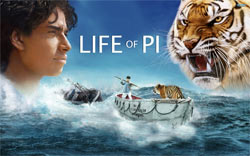 | « Back to article | Print this article |
 There are remarkable similarities between Bombay Jayashri's Oscar-nominated song in Life of Pi and Irayimman Thampi's age-old composition. We make a case for the 200-year-old melody.
There are remarkable similarities between Bombay Jayashri's Oscar-nominated song in Life of Pi and Irayimman Thampi's age-old composition. We make a case for the 200-year-old melody.
Almost every Keralite, including Tamil and other language speaking ones, would have been put to bed in their childhood listening to the strains of Omana Thinkal Kidavo, a lullaby composed 200 years back in April 1813 by Irayimman Thampi (rhymes with alphabet "p"), on the occasion of the birth of his nephew, Swathi Thirunal, who was called Garbhashriman, or one who was anointed king when he was in his mother's womb.
It was thus a lullaby composed for a king.
Swathi Thirunal, in his brief life of 33 years, went on to become one of the greatest administrators whose far-reaching reforms are one of the prime reasons why Kerala had a historical lead in almost every social indicator.
He was also a great patron of the arts and established himself as a great composer in different languages and is revered on the same footing as the great trinity of Carnatic music. Thampi himself has several well-known classical music and kathakali compositions to his credit, including probably the best known Malayalam songs which evoke the rasas of bhakti, shringara and vatsalya.
The lullaby seems to have now woken up every Keralite, as the descendants of Thampi have alleged that the opening song in Ang Lee's latest film, Life of Pi, is a copy of the early 19th century piece. The controversy got further enhanced as the song won two nominations for this year's Oscar Awards, including for "original song", the emphasis being on "original".
The two pieces can be compared at two levels. The first relates to the style of composition. Thampi's string of 25 couplets is all in the form of questions comparing the baby with some of the most endearing ideas and things in life, both animate and inanimate. These could be read as questions posed to oneself or to the child. This style used in composing a lullaby is the hallmark of Thampi's work and is unique to Malayalam, and perhaps to any other language. The same style is adopted in six of the eight lines in Bombay Jayashri's piece, and provides a strong undercurrent to the current controversy as it makes the other similarities stand out in relief.
The second relates to the content of the two lullabies. At least four of the six lines in Jayashri's piece bear close resemblances with that of Thampi:
1. Jayashri: Mayilo, thogai mayilo (Are you a peacock? Or its plumage?)
Thampi: Chanchadiyadum Mayilo (Are you the hopping and dancing peacock?)
2. Jayashri: Kuyilo, koovum kuyilo (Are you a cuckoo bird? A cooing cuckoo?)
Thampi: Mrudu panchamam padum kuyilo (Are you the cuckoo which sings the soft panchamam?)
3. Jayashri: Nilavo, Nilavin oliyo (Are you the moon? Or the moonlight?)
Thampi: Omanathinkal kidavo … Paripoornendu thante nilavo (Are you the beautiful moon? ... Are you the light of the full moon?)
4. Jayashri: Malaro, malarin amudho (Are you a flower? Or the nectar in the flower?)
Thampi: Nalla komala thamara poovo, poovil niranja madhuvo (Are you the good tender lotus flower? Or the nectar filled in the flower?)
The two remaining lines are a mere extension of the basic ideas of Thampi to eyelids and fruit. What is left are the opening lines, including Kanne Kanmaniye which resembles another piece, Kanne Navamaniye, sung by Jayashri herself for an album referred to below.
Some have argued, in comments on the net that the words kuyil, mayil, moon, flower, etc have been around for ages and nobody has exclusive rights to the same. But, the crux of the controversy is not about the mere use of these words, but the fact that more than half of Jayashri's work consists of words and phrases, which owe a debt, in their meaning and usage, metaphor, context, style, and even sequence (barring one or two interchanges),